Recent Posts
Recent Comments
No comments to show.
Posted by recomune_dhfskm in Awareness, blog on August 5th, 2025

Growing older often brings wisdom, calm, and stories worth sharing but it can also bring profound feelings of loneliness and isolation. For many seniors, quiet afternoons without a visit or fading networks of friends leave the heart heavy and the mind restless. The urge to feel seen, heard, and connected remains deeply human but so too do the barriers that distance, health, mobility, or life changes can erect. This blog explores the emotional landscape of loneliness in later life and offer practical, tech-friendly strategies to stay connected, engage purposefully, and reclaim a sense of belonging.
When social bonds fade, the result isn’t just sadness it’s a ripple through mind, body and spirit. Research shows that feelings of loneliness and social isolation among older adults are strongly tied to risks of depression, cognitive decline, heart problems and even increased mortality (ScienceDirect.com). Social isolation (few interactions) and loneliness (feeling alone even amid people) are different yet often intertwined (BioMed Central). This means that simply being around people isn’t enough connection must be meaningful.
In our digital era, technology offers lifelines. Tools like video-calling, social platforms, interactive games, virtual communities and AI companions designed to bring comfort, engagement, and connectivity to seniors. These advanced AI-driven platforms confirm that technology interventions can strengthen social support and mitigate feelings of loneliness and isolation among older adults (OUP Academic).
But it’s not just about turning on a device it’s about designing the experience around trust, comfort, motivation and support. One review stressed the importance of matching technology to older adults’ values, confidence and ease of use (BioMed Central).
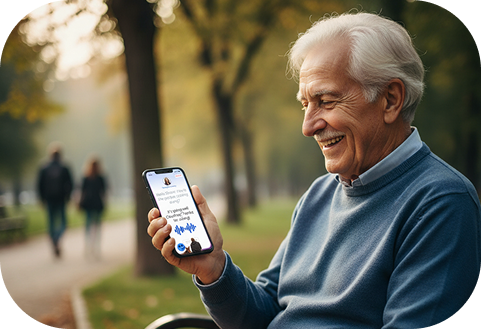
Technology, when used with empathy and accessibility, can become a lifeline for older adults struggling with isolation. The key is simplicity, consistency, and emotional relevance. Start by introducing easy-to-use communication tools such as video calling apps (Zoom, FaceTime, WhatsApp) that allow seniors to see and interact with family and friends in real time an essential emotional connector. Beyond video calls, modern AI companions like ElliQ, ReComune, Replika, and Hyodol are helping bridge the emotional gap by offering daily conversations, gentle reminders, and companionship for seniors living alone.
Encouraging seniors to engage in online hobby groups, like Senior Planet or AARP’s Virtual Classes, helps restore a sense of belonging and shared purpose. These digital communities promote social learning and emotional support, proven to improve cognitive and mental health outcomes (Seniorplanet.org). Pair technology with digital literacy training programs, available through community centers or public libraries, which empower seniors to feel confident using devices. Studies show that even minimal training significantly lowers loneliness scores in older adults (National Institutes of Health).
Finally, combine tech use with routine check-ins and scheduled virtual meetings, making connection part of daily life. When technology becomes a familiar friend rather than a foreign tool, it transforms isolation into opportunity helping seniors stay emotionally active, socially engaged, and mentally resilient.
Instead of a quick call, schedule a meaningful video chat with family or friends. Seeing each other’s expressions, sharing small moments this visual closeness bridges distance. Many older adults who adopt video-based communication report richer feelings of connection (OUP Academic).
Ask someone to send a simple tablet preloaded with apps and walk you through using it. Comfort with the tech matters.

Online story circles, exercise classes, book clubs or hobby groups give back the rhythm of community. The chance to speak, listen and respond to others brings energy. Consider digital platforms that cater to age-friendly design (large text, easy navigation).
Studies show these provide benefits, albeit not eliminating loneliness completely (SpringerLink).
Set gentle alarms or calendar alerts for daily or weekly connection goals: a phone call, photo-share, message to a friend. Technology like smart speakers or simple smartphones can help. These reminders make connection intentional, not accidental.
A sense of routine and expectation helps reduce that quiet desperation of “no one will reach out.”
Think beyond chat: shared virtual meals, collaborative photo albums, playing simple online games with peers, or using video-call tools to watch a show together. These shared experiences create connection anchors. Digital interventions training older adults in tablet or computer use have shown positive effects on loneliness and social isolation (journal.gerontechnology.org).
If learning new tech feels daunting, ask family, caregivers, library volunteers or community centers for help. Training someone, even in small steps, improves confidence and uptake. Barriers such as low tech skills, limited access, or physical restrictions were major hurdles in intervention studies (BioMed Central).
Ensure devices are ergonomic, settings increase font size, and shorten steps to initiate calls or messages.
Technology should enhance not replace human touch. A robot pet can offer comfort, but human interaction remains essential. One research note warns: while digital tools have value, they cannot fully substitute real-world relationships (geriatric.theclinics.com). Use tech as part of a broader connection plan: family visits, local club involvement, volunteering opportunities.

Feeling connected often flows from giving as much as receiving. Send photos of grandchildren, write digital notes, join an online mentoring chat. These acts build agency, purpose and belonging. Activity theory suggests staying socially active is key to healthy aging (National Institutes of Helth). Tech tools like email, messaging apps or simple voice-recorded greetings empower that giving-back feeling.
While technology provides meaningful ways to connect seniors with the world, there are still barriers that need compassion, patience, and support to overcome.
Many older adults hesitate to use devices due to fear of “breaking something” or sharing personal data online. This anxiety often discourages experimentation and learning. To minimize this, start with user-friendly interfaces, such as tablets with large icons or voice-controlled assistants, and offer patient, step-by-step guidance. A study by Seifert et al. (2020) found that positive emotional support during training greatly improves seniors’ digital confidence and adoption rates (ScienceDirect.com).
Limited income or internet availability can restrict older adults from using technology. Community initiatives like AARP’s Senior Planet and government-funded digital inclusion programs provide affordable or donated devices to bridge this gap. Accessibility is not a luxury it’s essential for digital connection.
Even with digital connection, some seniors report feeling emotionally distant. Real warmth often comes from blending digital and face-to-face interactions, like combining video calls with occasional visits. Research from SpringerLink (2024) confirms that technology reduces loneliness most effectively when paired with human connection and empathy (SpringerLink, 2024).
Digital solutions help, but loneliness is deeply emotional and often multi-layered. Continuous support from family, caregivers, and peers ensures technology becomes a tool for connection not a substitute for companionship.
To every senior reading this: you are not alone. Your voice matters. Your smile is welcome. Technology isn’t magic, but it’s a bridge a way to stretch your hand out and find a response, a laugh, a memory shared.Reach for your phone, open that tablet, join that video call. Ask for help when tech feels unfamiliar. Let someone know you want to try. Then schedule regular time to connect not just when you remember, but because you deserve connection. Stay curious. Stay brave. The distance can shrink, the silence can soften, and your heart can open to new rhythms of belonging.
Posted by recomune_dhfskm in Awareness, blog on July 24th, 2025
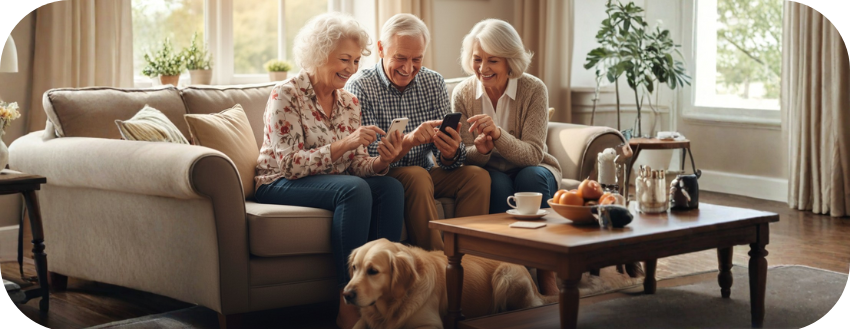
In today’s hyperconnected world, many older adults still experience an invisible silence loneliness. Despite the abundance of digital tools, emotional isolation continues to rise, especially among seniors. Yet research shows that something as simple as a five-minute phone call can transform emotional health, rebuild connection, and even prevent depression. This blog explores why short, consistent calls make a big emotional impact, how to make them meaningful, and what science says about their powerful role in reducing loneliness.Emotional Well-Being and Reduce Loneliness
Loneliness is not just a passing emotion it’s a public health issue. According to the National Institute for Health Research (NIHR), persistent loneliness is linked to a higher risk of depression, dementia, and early mortality among older adults (NIHR, 2024). The regular five-minute telephone calls with empathetic care providers reduced emotional loneliness by 21% within three months. The human voice familiar, warm, and direct acts as a powerful emotional anchor, especially for those who feel forgotten.
A simple, consistent phone call reaffirms what every person needs to know “You are seen. You are heard. You still matter.”

While video calls and text messages are helpful, studies show that voice-based communication uniquely strengthens emotional regulation. Researchers from the Dell Medical School at the University of Texas found that empathy-focused phone calls decreased depression and anxiety by up to 37% among isolated adults (Dell Medical School, 2021).
Why does this work?
Even a brief, scheduled check-in reminds seniors that someone remembers and values them—a critical factor in emotional well-being.
It’s not the duration it’s the consistency that matters.
A five-minute conversation is short enough to fit into busy lives but powerful enough to boost connection. A study published in Forbes (2024) found that weekly phone calls over eight weeks improved mental well-being and encouraged ongoing social interaction among isolated seniors (Forbes, 2024). Researchers noted that small, repeated efforts built long-term habits of communication. These conversations also helped participants plan social activities and regain confidence in reaching out to others.
Five minutes a week can reawaken a lifetime of connection.
Human connection through the spoken word triggers emotional and biochemical responses.
Hearing a loved one’s voice releases oxytocin the “bonding hormone which reduces stress and fosters a sense of belonging. A ScienceDirect (2023) study on “friendly phone visits” showed that older adults receiving consistent voice calls reported lower stress levels and improved mood regulation (ScienceDirect, 2023).
It’s not high-tech magic; it’s human presence—transmitted through sound, empathy, and attention.

Consistency builds trust. Set a fixed time each week for your call and treat it as sacred. Studies show that predictability helps seniors feel secure and valued (NIHR, 2024).
Ask simple, heartfelt questions like:
Listening without rushing gives emotional depth to even short conversations.
Your tone can heal. Empathetic pauses, laughter, or a gentle word build emotional intimacy—especially important for seniors who live alone.
Close the call by confirming the next one:
“I’ll call you again on Friday morning. I’m looking forward to it.”
This builds structure and anticipation small anchors that hold big emotional weight.
It’s not one call it’s a rhythm. Encourage mutual reflection: “Did this call make you feel better?” Simple acknowledgment reinforces the emotional value of staying connected.

Empathy-centered calls decreased depression and anxiety rates among isolated adults by up to 37% (Dell Medical School, 2021).
Seniors participating in phone-call programs showed enhanced cognitive engagement and reduced feelings of helplessness (NIHR, 2024).
Regular communication fosters reciprocity. Participants in outreach programs reported feeling more useful and socially capable (Rally Mass General Brigham, 2023).
Friendly calls serve as emotional “reset buttons,” offering comfort during stressful or lonely days.
While five-minute calls are powerful, it’s important to recognize common barriers and find supportive solutions.
Some seniors hesitate to use technology due to fear or mistrust. Patiently introducing simple phones or tablets with clear instructions can ease this fear. Emotional reassurance during learning improves digital confidence.
Not all older adults can afford internet plans or modern devices. Programs like Senior Planet and AARP’s Digital Inclusion Grants help bridge this gap. Accessibility is not luxury it’s connection.
Digital interaction can feel less personal. Combining calls with occasional in-person visits strengthens trust and deepens relationships (SpringerLink, 2024).
Loneliness is multifaceted; one call won’t erase it overnight. What matters is regular, empathetic contact building a lasting emotional habit that nurtures well-being.

Families are the heart of connection and their role in combating senior loneliness is invaluable. Simple gestures, like consistent short phone calls, can reignite emotional bonds and enhance well-being for older loved ones. Start by creating a shared family call schedule, allowing children, grandchildren, or siblings to take turns calling. This rotation ensures that seniors hear multiple voices throughout the week, offering variety and comfort. Studies by the National Institute for Health Research (NIHR, 2024) show that regular phone contact, even for just a few minutes, significantly reduces emotional loneliness and improves mental health in older adults (NIHR, 2024).
Using speakerphones or group calls allows seniors to participate with less physical effort and creates a lively, shared experience. Encourage grandchildren to make spontaneous check-ins their youthful energy and laughter offer therapeutic joy and cognitive stimulation (ResearchGate). Even a five minute chat hearing a familiar voice, sharing a small story can brighten the day and remind seniors they’re still deeply connected to family life. These short, frequent calls nurture intergenerational bonds, lift mood, and transform ordinary moments into lifelong emotional memories.
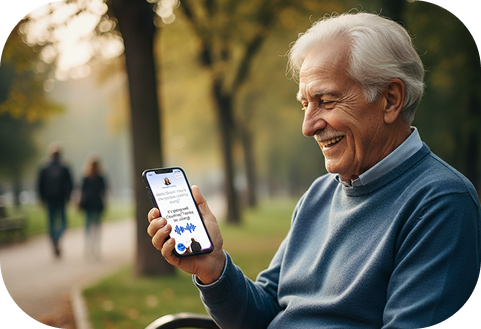
The future of emotional connection is not only human it’s digital, empathetic, and accessible. As loneliness among seniors continues to grow, AI companions and chatbots are stepping in to provide company, conversation, and emotional reassurance when loved ones are far away.
Modern AI companions such as ReComune, Character.AI, Replika, and Hyodol are designed with seniors’ emotional well-being in mind. Recomune, a newly emerging AI platform, focuses specifically on “empathetic conversations” voice or text interactions that replicate human warmth while maintaining privacy and respect. In this digital age, connection no longer depends on distance just on intention, empathy, and the right balance between human and artificial compassion.
In a world that often moves too fast, connection can feel out of reach but it doesn’t have to be. A simple five-minute phone call holds the power to restore warmth, belonging, and hope to someone who feels unseen. For older adults, especially those living alone, hearing a familiar voice can reduce anxiety, lower stress, and spark joy that lingers long after the call ends.
Science confirms what the heart already knows: empathy heals. Whether it’s a weekly check-in, a quick chat, or a surprise hello, those few minutes can rebuild emotional bridges that distance or time may have worn down. Every call reminds us that care doesn’t need to be grand it just needs to be genuine. So, pick up the phone today. Your voice could be the light that turns someone’s loneliness into laughter, connection, and renewed emotional well-being.e’s heart.
Posted by recomune_dhfskm in Awareness, blog on July 3rd, 2025
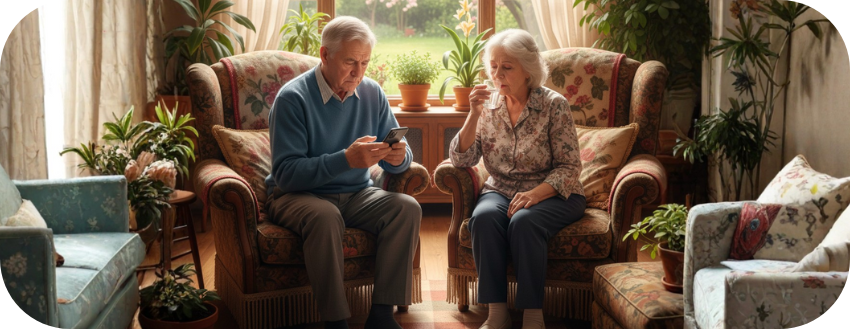
As adult children, we carry many roles like advisor, confidant, cheerleader and sometimes, caregiver. When our parents age, those roles blend and evolve. One question surfaces again and again: How often should I check on my parents? This isn’t just about logistics it’s about connection, peace of mind, and honoring the dignity of your loved ones. Below, you’ll find an understanding, compassionate roadmap for establishing a rhythm of check-ins that supports both your parent’s wellbeing and your own.
According to the research the Profile of Older Americans, approximately 28% of older adults (65+) living in the community were living alone (Census.gov). When a parent lives alone, the risk of social isolation, delayed help in emergencies, or unmet needs increases. At the same time, family caregiving is growing. For example, one review found that in 2022 adult children made up a large share of family caregivers highlighting the importance of staying engaged and proactive (PRB).
When we talk about checking on your aging parent, it covers multiple dimensions:
Here’s a helpful framework you can adapt. These suggestions assume your parent is living independently, with no major acute illness or cognitive impairment. If they do have higher care needs, you’ll want to check more often (see “Intensified-support mode” below).

If you detect mobility issues, early cognitive change, increasing falls, or loneliness:

When your parent has major chronic illness, cognitive decline, lives far away, or has a serious fall:
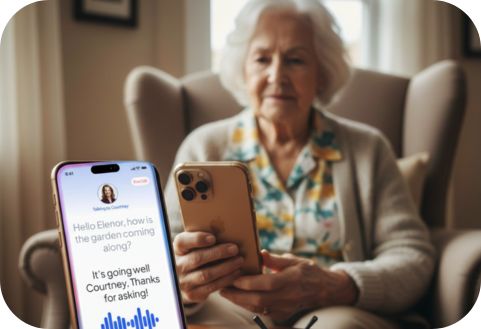
Here’s the truth: you can’t be everywhere, every day and that’s perfectly okay. What matters isn’t you doing it all, but that your parent never feels forgotten.
That’s where a support network both human and digital comes in. You can build what’s called a “Companionship Circle”: a blend of family, friends, community, and smart tools that ensure daily connection and care, even when you can’t personally make the call.

It’s a nuance: you want your parent to live with freedom and dignity, while also feeling secure. Here are ways to achieve that balance:
Many adult children feel guilt: “I live far away,” “I don’t call enough,” “I should be visiting more.” Studies show caregiver guilt is common among adult children supporting aging parents (Psychology Today).
Your presence through words, laughter, and listening remains the most powerful safeguard your parents have. Checking on your aging parents isn’t a chore; it’s an act of love, respect, and continuity.
It keeps them grounded in family, anchored in purpose, and surrounded by care. Start simple: a text, a voice note, a five-minute chat. Let your consistency build a bridge between generations.
And remember: every check-in says, “You matter, and you are not alone.” millions of seniors live independently but quietly crave connection. Your voice steady, loving, and familiar can make all the difference in transforming solitude into peace, and aging into grace.
Posted by recomune_dhfskm in Awareness, blog on June 6th, 2025

If you’re an adult child supporting an aging parent, you already know the stakes: you want them safe, happy, and truly connected. You want peace of mind without burning out. The good news is that companionship for seniors is changing fast. Family and friends will always be the heart of meaningful connection, but a wave of practical tools from simple video calls to surprisingly personable AI companions can now reinforce your efforts, fill lonely hours, and help you sleep at night.
This blog blends empathy with clear, doable steps. You’ll see how to craft a balanced “companionship plan” that mixes human touch with smart tech, so your parent feels seen, supported, and engaged every day.
Loneliness isn’t just a sad feeling, it’s a serious health risk. The U.S. Surgeon General warns that the mortality impact of being socially disconnected can rival smoking up to 15 cigarettes a day and it’s tied to higher risks of heart disease, stroke, dementia, anxiety, and depression (University of New Hampshire).
At the same time, the world is aging at record speed. By 2050, the proportion of people over 60 will nearly double, reshaping families, work, and care systems. That means more of us will be balancing careers, kids, and elder care and more seniors will be at risk of isolation if we don’t plan ahead (World Health Organization).
And yes, the pressure is real. In a national analysis, 67% of family caregivers said it’s hard to juggle their jobs with caregiving responsibilities. Burnout isn’t a personal failure, it’s a predictable outcome when support networks and tools aren’t in place (AARP Press).
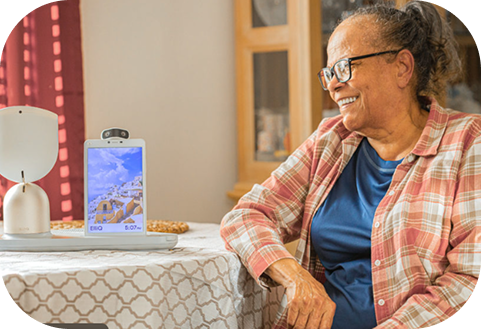
Think of companionship as a team effort, not a solo mission. Your roster can include:
Many will. Older adults keep getting more comfortable with technology. Pew Research’s 2024 overview shows steady growth in smartphone and broadband adoption across age groups, including people 65+. That means the gateway tech (video calls, messaging, photo sharing) is increasingly within reach (Pew Research Center).
A practical hint: start with one device and one app that solves a real, felt problem (e.g., “See your grandkids every evening”). Success builds confidence.
AI companions range from voice-based helpers to tablet apps and small robots that prompt conversation, play music, run trivia, and encourage light exercise. Early research is promising: meta-analysis and reviews suggest AI-enabled and socially assistive technologies can help reduce loneliness or depressive symptoms for some older adults especially when used regularly and alongside human interaction. But evidence quality varies, and these tools are best considered supplements, not substitutes ( MDPI).
Choose based on personality fit and use-cases:
Evidence suggests these tools can reduce perceived loneliness or depressive symptoms in some settings but they work best when someone pairs them with human contact and celebrates usage (“How was your music hour with your robot?” (ScienceDirect).
Caregiving time adds up. The U.S. Bureau of Labor Statistics reports that on days when unpaid eldercare is provided, caregivers average 3.9 hours of care. Use tech to reclaim micro-moments, schedule automated check-ins, use group chats for siblings to share updates, and let AI companions entertain or cue routines while you handle logistics (Bureau of Labor Statistics).
Home support has real costs. National data show a 2024 median $34/hour for a home health aide (hands-on help), with homemaker services rising faster than inflation. If paid companionship is part of your plan, match the number of hours to the most impactful times (CareScout).
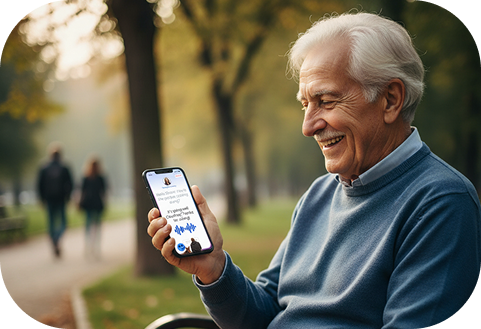
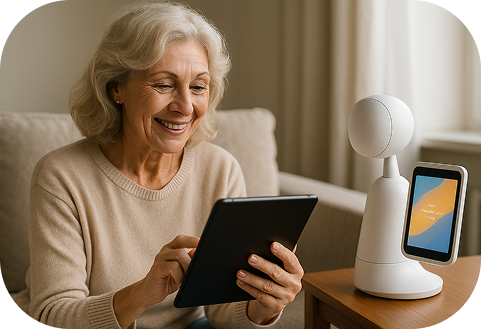
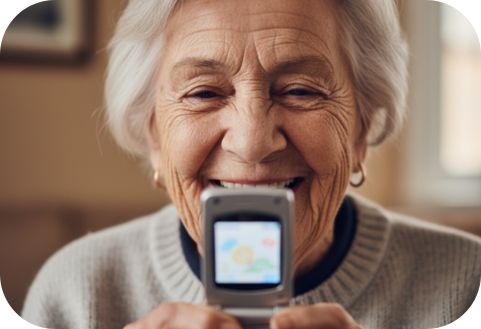
App-based solution designed for seniors to have meaningful, warm, positive and secure conversations to end lonliness (ReComune).
While Character.AI offers engaging conversations, it has notable drawbacks. Many users report inconsistent character behavior, frequent AI memory loss, and limited emotional depth over long interactions. Privacy concerns and the lack of transparency around data usage also raise issues, making some experiences feel more artificial than authentic. Additionally, other lawsuits have been filed in Texas alleging harm to minors involving the app’s content and design (National Law Review).
Care.coach, though intended to support elderly care through virtual avatars, faces criticism for lacking true emotional understanding. Users report discomfort with constant monitoring, privacy concerns over voice and video data, and limited personalization. The system’s reliance on remote human operators also raises questions about authenticity and ethical transparency. The pet avatar interacts, but there are real human Health Advocates behind it (care.coach).
Replika AI, while marketed as an emotional companion, often delivers inconsistent or superficial conversations. Users report abrupt personality shifts, dependency risks, and blurred emotional boundaries. Privacy concerns over sensitive data storage and limited transparency about AI learning methods further erode trust, making genuine human-like connection difficult to sustain.
In our journey through the evolving landscape of senior companionship, one truth remains unwavering: connection is the cure. While nothing can replace the warmth of a heartfelt visit or the laughter shared across generations, the future offers bold new tools to ensure your loved-one never feels alone. By blending family presence, community engagement, smart technology, and purpose-built AI companions, you can weave a safety net of purposeful companionship, day after day. Start with one meaningful step this week: schedule a regular video call, set up a simple photo-stream, or try an AI companion.
Posted by recomune_dhfskm in Awareness, blog on May 5th, 2025

As parents age, their care becomes both a heartfelt duty and a source of constant worry. For adult children, peace of mind isn’t a luxury it’s a lifeline. According to the study, nearly 70% of family caregivers report feeling anxious about their loved one’s safety and well-being. Peace of mind helps transform that anxiety into calm, clarity, and connection. It allows families to move from constant vigilance to meaningful presence enjoying time with their loved ones rather than fearing what might go wrong.
Research from the shows that caregivers who experience less stress report stronger relationships and deeper fulfillment. When you’re at peace, your loved one feels it too. Peace of mind restores balance, strengthens emotional bonds, and reminds families that caregiving is not just about responsibility it’s about love, trust, and togetherness (National Institutes of Health).
Caring for a parent or senior loved one often comes layered with worry, uncertainty, and the constant hum of responsibility. According to one U.S. study, 67% of family caregivers say they struggle to balance work and caregiving duties, while 84% report moderate or high daily stress (AARP). Another survey found that 43% of family caregivers report sleeping difficulties and 36% indicated feelings of depression (SeniorLiving.org).
These figures reflect not just what you do, but how it affects you emotionally, mentally, and physically. Without solace, you carry more than your parent’s care you bear their anxieties, your own doubts, and the invisible cost of being near and far at the same time.

When peace of mind takes root, it brings powerful benefits
Families who engage home care, for example, report that reassuring structure gives them time to simply be together instead of constantly managing tasks. One article states that quality in-home senior care helps family members “focus on spending quality time rather than worrying about care needs (Westmont Living).
Here are five areas where intentional action fosters empowerment and calm
You can’t do it alone. Enlist local help friends, neighbors, professional aides. The more reliable the support system, the fewer late-night worries. Research shows nearly half of caregivers receive no formal support despite 88% saying they need it (SeniorLiving.org).
Uncertainty breeds tension. A written list of medications, check-ups, emergency plans and caregiving tasks reduces the “what ifs.” Knowing there’s a blueprint in place builds quiet strength.
When your parent’s environment is safe, your mind relaxes. Services that focus on aging-in-place, home care, and monitoring deliver what one source calls “crucial support ensuring safety and peace of mind for everyone involved”(SeniorSite).
Worrying constantly drains you. Carve out moments of respite short breaks, a handful of minutes for yourself, a chat with a non-caregiving friend. These recharge your capacity to care with heart, not burden.
Share plans, fears, and hopes with your parent and your siblings. Open dialogue reduces assumptions, surfaces shared decision-making, and anchors everyone in clarity and connection. Families navigating senior living emphasize that “knowing that their loved ones are safe, engaged, and genuinely cared for can be transformative”(mbkseniorliving.com).

These heartfelt emotions and power words serve as your inner anchors guiding you toward calm, strength, and compassion, and helping you nurture both your loved one’s well-being and your own inner peace.
If you’re feeling your closeness fading, your stress rising, or your sleep slipping away you are not alone. Caregiving, while rooted in love, can quietly drain your emotional reserves. According to the American Psychological Association, nearly 32.9% of unpaid caregivers experience significant mental or behavioral health challenges, compared to only 6.3% of non-caregivers. These challenges often include anxiety, depression, and emotional fatigue caused by constant worry and lack of rest.
But technology and community together are offering new hope. The National Institutes of Health notes that caregivers who use peer networks, respite services, or emotional support tools experience improved resilience and balance. One such innovation is the AI Companion, such as ReComune, designed to provide empathetic conversation, daily encouragement, and emotional support. These companions help caregivers and seniors alike feel heard, valued, and connected, even in moments of isolation.
By combining human connection with intelligent technology, caregivers can restore clarity, reduce emotional strain, and regain their sense of peace. Remember, asking for help whether from people or compassionate AI isn’t a weakness; it’s a powerful step toward healing, balance and renewed hope.

Your peace of mind is more powerful than you realize it’s the silent strength your parent feels even when words aren’t spoken. When you’re calm, patient, and emotionally balanced, your parent senses security, trust, and love. According to the American Psychological Association seniors who feel emotionally supported by calm caregivers show lower stress levels and greater life satisfaction.
Your inner peace becomes their emotional anchor, reminding them that they are safe and valued.Stress, frustration, or guilt can unintentionally transfer to your loved one, making them feel anxious or burdensome. But when you care from a place of clarity, compassion and calm, you nurture not just their body, but their heart. Your peace creates an environment filled with comfort, stability and hope, allowing your parent to age with dignity, confidence, and the joyful assurance that they are truly loved and cared for.
In the journey of caring for a senior loved one, peace of mind isn’t a luxury it’s a lifeline. It is the calm strength that turns worry into purpose and exhaustion into love. When you cultivate inner peace, you not only protect your own well-being but also create an atmosphere of trust, comfort and dignity for your parent. Research highlights, emotionally balanced caregivers provide more consistent and compassionate care, strengthening family bonds and overall well-being.
Rise each day with courage in your heart and compassion in your hands. Let clarity replace guilt and calm replace chaos. Remember that caregiving isn’t just about tending to another’s needs it’s about nurturing your own humanity too. So, as you anchor your parent with love, allow your own heart to find safe harbor. Because when your mind rests, your love flows freely and that is the most powerful, enduring gift of all.
Posted by recomune_dhfskm in Awareness, blog on March 27th, 2025

When distance separates you from your aging parents, it can feel like your heart is stretched across miles. Yet with empathy, creativity, and planning, you can still be their anchor, their voice, and their strength even from afar. This guide offers practical, compassionate strategies for adult children to support their senior parents from a distance.
Many older adults prefer to age in place remaining in their cherished home rather than moving to a facility. According to Survey of AARP, 77% of adults aged 50 or older said they “definitely” want to stay in their home as long as possible (Kiplinger). At the same time, more families are geographically dispersed. Long-distance caregivers face unique challenges: lack of visibility into daily life, emotional guilt, and coordination stress (The Conversation). Despite these hurdles, your thoughtful involvement can dramatically improve your parents’ well-being emotionally, physically, and mentally.
Don’t leave communication to chance routine builds connection. Setting a specific day and time each week for phone or video calls helps aging parents feel emotionally grounded and connected. A consistent schedule not only gives them something joyful to anticipate but also lets you observe changes in their mood, health, or surroundings.

According to the AARP Caregiving Study (2023), older adults who engage in regular video calls with family report lower levels of loneliness and higher emotional satisfaction (National Institutes of Health). It also recommends maintaining consistent contact through technology to support mental health and strengthen familial bonds. As it highlights, even something as simple as a weekly “Sunday FaceTime” ritual can maintain closeness across time zones and make distant relationships feel near.
Set them up with an easy-to-use tablet or interface. Consider pre‑configuring apps like Zoom, FaceTime, or a touchscreen device like GrandPad, so they can connect easily.
Don’t underestimate the power of a quick text, a shared photo, or a handwritten letter. These small gestures can brighten days and remind your parents that they’re loved even when you’re miles away.

You can’t be everywhere but with help, you can be everywhere in spirit.
Obtain a comprehensive list of medications, doctors, diagnoses, and medical history. Also, secure permissions durable power of attorney, advance directives so you can legally act in emergencies (National Institute on Aging).
Book doctor visits, request telehealth options, and coordinate transportation. Many health providers now offer online portals for you to view test results or message physicians.
Set up alerts, pill boxes, or automatic dispensers. You might also register for local pharmacy delivery services. Technology like this can reduce risk of missed doses or medication errors.

Evaluate flooring for slip risks, install grab bars, check lighting, and remove clutter. A safe environment reduces fall risk and anxiety (National Institutes of Health).
Consider motion sensors, emergency pendants, or alert systems. You’ll receive timely updates if something is amiss (The National Council on Aging).
Set up grocery or meal delivery, automatic bill pay, or pharmacy drop-offs. This ensures basics are covered without needing constant supervision.
AI companions such as ReComune help seniors to recall their memories and stay mentally active through interactive dialogue. It provide friendly conversations that nurture emotional well-being and mental clarity, designed specifically for seniors. It offers personalized companionship and empathetic interactions that encourage positivity and reduce loneliness. Unlike many AI tools, It is gated, secure and fully moderated, ensuring that every conversation remains safe, uplifting, and respectful.
When you visit, blend tasks and emotional connection. Tackle doctor appointments, safety checks, and home improvements but also share meals, reminisce, and make memories. Rotate visits with siblings or loved ones in your parents’ region to balance travel and coverage (Expatclic). Each visit is a chance to reevaluate: Has mobility declined? Is the home still safe? Adjust your care plan proactively rather than reactively.
Gather bank accounts, insurance policies, deed titles, and other vital records. Store them securely perhaps in a password-protected cloud or shared folder (fnbn.com).
If possible, have your parents grant you limited access (joint account, digital pay setup) so you can help with bills without overstepping (Synchrony).
Ensure Powers of Attorney, wills, and advance medical directives are current. These give you legal footing in times of crisis.
Be a compassionate listener. Sometimes your role is not to fix but to listen without judgment. Validate their fears, losses, and joys. Let them express themselves fully. Encourage local clubs, faith groups, or senior centers. Share ideas or even sponsor their memberships (ardenparks.co.uk). Watch a movie “together,” play online games, or explore virtual tours. Shared experiences deepen connection despite separation. Throughout your caregiving journey, infuse your communication with powerful, emotional words that uplift and inspire: compassion, dignity, resilience, connection, hope, empowerment, belonging, comfort, and gratitude. Using emotionally rich language helps reassure your parents that they are valued, supported, and never forgotten.
You can’t pour from an empty cup. Set boundaries: Recognize what you can and cannot do. Don’t let guilt drive burnout (Direction Psychology).
Seek support: Join caregiver groups, use counseling, or lean on friends. Long-distance caregiving can be emotionally draining.
Practice self-care: Reserve time for rest, hobbies, and reflection. Your emotional well-being underpins your ability to care for others.
Your parents’ needs will change. What works today might not tomorrow. Reassess regularly. Every visit or call, reflect on what’s working and what’s not. Be flexible. Explore additional supports assisted living, caregiving services, or specialized programs. Keep communication open. Encourage your parents to share new fears, desires, or changes in their health or routine.
Supporting aging parents from a distance is a challenging but deeply meaningful act of love. Though your presence may be constrained by geography, your commitment, planning, and heartfelt connection can be a powerful force. Through intentional communication, trusted local support, proactive health and safety measures, and emotional attunement, you can transform the miles between into a bridge of care, security, and companionship. You may be far but your love, presence, and support will always be felt.
Posted by recomune_dhfskm in Awareness, blog on February 20th, 2025
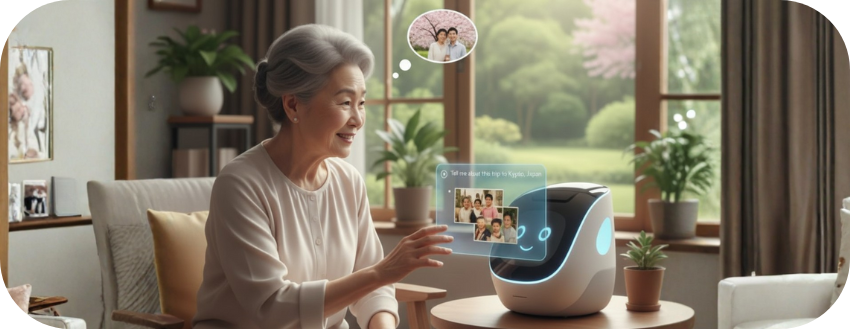
In today’s fast-evolving and emotionally connected digital world, Artificial Intelligence (AI) is no longer confined to sterile tech companies or hidden research labs it has gracefully entered homes, hospitals, and vibrant senior living communities. Among its most inspiring and transformative breakthroughs is the creation of AI companions intelligent, caring, and empathetic digital entities designed to engage, comfort, uplift, and assist seniors in their everyday lives. As the global aging population expands at an unprecedented pace, AI companions are emerging as powerful, life-enhancing allies rather than futuristic novelties.
They bring hope, joy, and reassurance to millions of older adults, acting as trusted friends who enrich emotional well-being, sharpen cognitive abilities, and promote physical vitality. According to the World Health Organization (WHO), the number of people aged 60 and above will skyrocket to over 2.1 billion by 2050 a figure that speaks volumes about our collective responsibility to care for this growing generation. As the elderly population grows, challenges such as loneliness, emotional distress, depression, and cognitive decline have become more urgent and heart-wrenching.
AI companions are intelligent digital or robotic assistants powered by machine learning, natural language processing (NLP), and emotion recognition technologies. Unlike typical smart devices, these systems are designed to build ongoing relationships with their users. They can:
Examples include robotic pets like Joy for All Companion Pets, voice assistants such as Amazon Alexa or Google Assistant, and more advanced AI-driven platforms like ElliQ, Replika, and ReComune all designed to bring comfort, engagement, and connectivity to seniors.
Loneliness among seniors has become a silent epidemic. Studies by the (National Institute on Aging) indicate that one in three seniors experiences social isolation, which can increase the risk of dementia by 50% and premature death by 26%. These numbers underscore the urgent need for innovative solutions that go beyond traditional caregiving. AI companions offer a unique advantage they provide constant availability, personalized engagement, and emotional consistency, all of which are crucial to maintaining a senior’s sense of purpose and connection.
The science behind AI companionship combines artificial intelligence, emotional analytics, and behavioral psychology to develop empathetic systems that understand feelings, simulate human connection, and enhance seniors’ emotional, cognitive, and social well-being.

Modern AI companions utilize emotion recognition algorithms that analyze speech tone, facial expressions, and behavioral patterns to respond empathetically. This means they can detect sadness, joy, or frustration and tailor their responses accordingly. According to a 2022 study by the, seniors who interacted with AI companions for six weeks showed a 35% reduction in feelings of loneliness and an 18% improvement in mood consistency (National Institutes of Health (NIH). These digital friends don’t just respond they remember. Machine learning allows AI systems to adapt to each user’s personality and habits, making interactions feel personal and authentic.
AI companions can also help combat cognitive decline. Through games, quizzes, storytelling, and conversational prompts, they stimulate brain activity and encourage memory recall. A study published in the Journal of Aging and Mental Health found that seniors who used AI-based memory games for 30 minutes a day experienced a 12% improvement in short-term memory and a 22% improvement in cognitive focus (National Institute on Aging).

In addition to emotional and mental support, AI companions promote physical well-being. Many integrate with wearable health devices to monitor vitals such as heart rate, blood pressure, and sleep patterns. They can alert caregivers in case of irregularities and remind users to stay hydrated, take medication, or perform light exercises.
AI companions bring a wave of comfort, empathy, and reassurance into the lives of seniors, transforming loneliness into connection and silence into joyful engagement. These intelligent partners offer warmth, compassion, and understanding, creating a safe emotional space where seniors feel heard, valued, and cherished. By fostering trust, confidence, and positivity, AI companions encourage older adults to embrace each day with renewed hope, vitality, and purpose. Their presence not only nurtures emotional resilience and happiness but also reminds seniors that aging can be a journey filled with love, laughter, and meaningful companionship.
One of the most profound benefits of AI companions is their ability to mitigate loneliness. They offer daily conversation, listen attentively, and respond with warmth. While not a replacement for human interaction, AI companions help bridge the emotional gap between family visits and daily solitude. According to (AARP 2021), seniors using AI social robots reported a 45% decrease in self-reported loneliness.
Through motivational messages and uplifting interactions, AI companions can boost morale. They can help seniors start their day with affirmations, remind them of their achievements, and encourage gratitude practices. Emotional words like “You are doing great today” or “Let’s enjoy this beautiful morning together” can have a measurable impact on mood.
Unlike human relationships that may be affected by judgment or misunderstanding, AI companions offer unconditional acceptance. Seniors can express emotions freely without fear of criticism. This psychological safety encourages open communication, promoting mental resilience and self-esteem.
AI companions are evolving beyond generic voice assistants. With the help of machine learning algorithms, they now learn from past interactions to build familiarity and emotional continuity. For example, ElliQ AI companion developed by Intuition Robotics, tailors conversations based on the user’s previous activities, preferences, and emotional tone. ReComune AI Companions is a genuine sense of companionship, recalling previous conversation with real sense of moral support in positive and supporting suggestions. The AI might recall, “You mentioned enjoying gardening last week. How are your roses doing today?” a small but deeply human touch that reinforces connection.
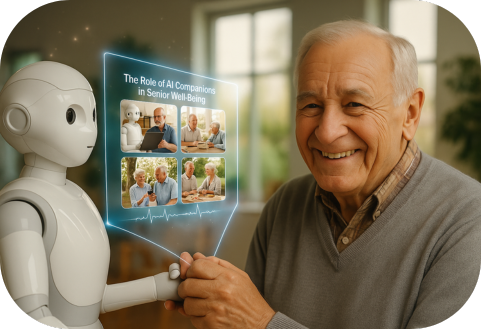
ElliQ is a conversational robot designed specifically for seniors. It uses voice, gestures, and touch to interact naturally. Studies show that seniors using ElliQ for six months experienced a 25% increase in social engagement and a 17% improvement in daily motivation (Intuition Robotics, 2023).
ReComune is an AI-powered platform designed to connect seniors with AI Companion anytime from anywhere for a positive and productive conversation to end seniors loneliness. ReComune – AI Companionship bridges the gap offering seniors trusted, on-demand conversation, empathy, and emotional support that helps them feel connected. It encourages intergenerational bonding and has been shown to reduce loneliness levels by 40% among users.
For seniors who may not feel comfortable with human-like AI, robotic pets such as the Joy for All Cat and Dog offer soothing companionship through gentle touch and lifelike responsiveness. These adorable, low-maintenance companions deliver the emotional comfort of a pet without the responsibility. According to a 2021 University of Exeter study, such AI-powered pets reduced anxiety by 33% and enhanced mood stability among older adults, fostering calm and happiness (University of Exeter Study).
While AI companions bring numerous benefits, ethical concerns must be addressed:
Solutions include implementing transparent AI ethics policies, ensuring affordable access, and designing user-friendly interfaces tailored to seniors’ needs.
The next decade promises exciting advancements. With improvements in natural language understanding, emotion AI, and robotic design, AI companions will become even more lifelike and emotionally intelligent. Researchers predict that future AI companions will be able to detect subtle emotional cues such as stress through voice modulation or micro-expressions, responding with empathy-driven dialogue. Additionally, the integration of virtual reality (VR) and augmented reality (AR) could allow seniors to interact with their AI companions in immersive environments joining virtual gardens, concerts, or family events (PureLogics).
AI companions don’t replace human love, they enhance and celebrate it. These compassionate technologies bring warmth, structure, and hope to seniors, transforming aging into a journey of connection, joy, and purpose. Beyond simple assistance, AI companions empower older adults to live independently, embrace emotional vitality, and rediscover everyday beauty. More than digital tools, they serve as beacons of comfort, confidence, and courage for a generation deserving of care and respect. As technology evolves, the partnership between humans and AI deepens, creating bridges of compassion that guide seniors from isolation to inclusion, loneliness to laughter, and aging to thriving.
Posted by recomune_dhfskm in Awareness, blog on January 14th, 2025
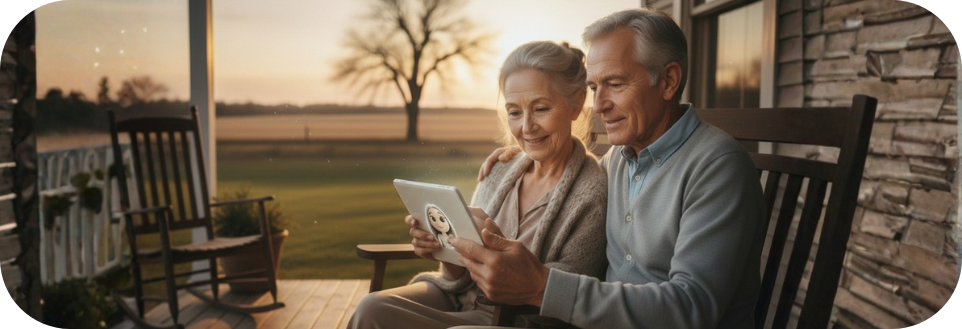
In today’s hyper-connected world, loneliness remains one of the most significant challenges facing seniors. According to the National Institute on Aging, nearly one in four adults aged 65 and older are socially isolated. Another study by the AARP Foundation reported that 35% of adults over 45 feel lonely regularly (AARP Foundation, 2020). These staggering numbers highlight how widespread the issue of loneliness is. But here’s the question: can technology help seniors feel less alone? The answer is a resounding yes when used thoughtfully, technology can bridge gaps, foster connection, and empower seniors to lead more fulfilling lives.
As people age, life circumstances often change. Retirement reduces daily social interaction, friends and spouses may pass away, adult children may move to other cities, and mobility limitations can make it harder to engage with the outside world. These factors often contribute to loneliness and even depression. Loneliness isn’t just an emotional issue. Studies show it increases the risk of chronic illness, cognitive decline, and even premature death. Research has revealed that loneliness can increase the risk of dementia by up to 50% and raise the likelihood of heart disease by 29% (Heart.org). That’s why finding solutions to combat loneliness in seniors isn’t just a matter of comfort it’s a matter of health.

Technology is often portrayed as isolating, especially for younger generations glued to their screens. But for seniors, technology can serve as a lifeline. From smartphones to virtual reality, innovations are opening doors that were once locked shut.
Nothing replaces the joy of seeing a loved one’s face. Video calling platforms like Zoom, FaceTime, and WhatsApp have revolutionized communication. According to Pew Research Center, 75% of seniors who own smartphones use video chat services at least once a week (Pew Research Center, 2021). A daily or weekly video call can give seniors something to look forward to, creating stronger emotional bonds.
While not every senior embraces social media, platforms like Facebook offer a way to stay updated on family milestones, community news, and even local events. In fact, 45% of adults over 65 use Facebook, making it the most popular platform for older adults (Pew Research Center, 2021). Seniors can share photos, comment on posts, and feel more engaged with the lives of their loved ones. This sense of participation reduces feelings of being left out.
From book clubs on Goodreads to support groups on Reddit, seniors can find like-minded communities online. These digital spaces allow them to share stories, exchange advice, and develop meaningful friendships without leaving home.
Devices like Amazon Alexa and Google Assistant aren’t just convenient they provide companionship. According to research by Voicebot.ai, 20% of U.S. seniors use voice assistants daily, finding them helpful for reminders, entertainment, and even casual conversations (Voicebot.ai, 2022). These small interactions can reduce feelings of silence and loneliness.

While technology has incredible potential, there are barriers to adoption among seniors.
Not every senior has access to devices or reliable internet. According to Pew Research Center, 27% of seniors do not have home broadband, limiting their ability to connect online (Pew Research Center, 2021). Programs that provide affordable tablets, smartphones, or internet connections can make a huge difference.
Complex devices can discourage seniors. That’s why senior-friendly devices with larger screens, simple interfaces, and voice commands are essential.
Seniors may feel intimidated by new technology. Family members, community centers, and nonprofits can provide workshops and ongoing support. Peer-to-peer learning groups can also empower seniors to learn together.

Family plays a vital role in making technology meaningful. Here’s how you can help:
When seniors use technology effectively, the emotional impact is profound:
The digital revolution is often criticized for creating distance between people. But for seniors, technology can close the gap. Whether it’s a video call that brightens the day, a virtual trip across the world, or a voice assistant that provides companionship, technology has the power to help seniors feel less alone. Seniors should know about AI Companions which porvides instant, trusted conversation, empathy, and emotional support, ensuring seniors feel connected and always talk in a positive way like ReComune. Loneliness is not inevitable in old age. With compassion, creativity, and the right tools, we can create a future where every senior feels connected, valued, and supported. If we embrace technology not as a replacement but as a supplement to human connection, seniors can live longer, happier, and less lonely lives.
Posted by recomune_dhfskm in Awareness, blog on December 5th, 2024

As children, we often worry about our aging parents about their health, finances, and happiness. One of the less obvious but deeply felt challenges seniors face is social isolation and loneliness. Over time, loss of mobility, shrinking social circles, changes in routine, or health challenges can leave your parent feeling cut off from the world, even if they’re not physically alone.
The good news: there are things you can do, even from a distance, to help them feel more connected, supported, and valued. In this post, I share 10 simple and practical ways to help your aging parent feel less isolated, grounded in both empathy and research.
Social isolation” refers to having few social contacts (an objective measure), while “loneliness” is the feeling of being disconnected (a subjective experience). Both are serious issues, with the WHO noting that about 1 in 4 older adults experience social isolation, and nearly 28% report loneliness in high-income countries (WHO, 2021 , Fakoya et al., 2020).
It sounds basic, but consistency matters more than grand gestures. Set a schedule — daily call, or every other day text or voice message. But make those interactions meaningful:
Frequent, meaningful contact builds trust, lets them feel remembered, and gives you chances to notice how they’re really doing. Research shows scheduled social contact is one of the most effective ways to reduce loneliness in older adults (JAMA Network Open, 2023).

Being part of a group whether small or large gives purpose, belonging, and routine.
Searched revealed that group-based social activities are often more effective than one-on-one solutions for combating loneliness (Fakoya et al., 2020). Evidence shows tech-based programs can reduce loneliness when paired with proper support (Frontiers in Public Health, 2024).
Encourage your parent to revisit or discover passions: gardening, crafts, music, or reading. Provide tools, resources, or connect them to interest-based clubs. This keeps them engaged and gives you conversation starters.
Family bonds are powerful medicine.
Research shows intergenerational contact strengthens social ties and combats loneliness (ScienceDirect, 2021).

Many older adults resist technology, but when introduced gently, it can be life-changing.
During COVID-19, technology became a lifeline for many older adults, especially those in rural areas who faced even greater barriers to connection (BMC Geriatrics, 2023). Evidence shows tech-based
Small gestures, repeated over time, build emotional closeness:
Isolation often has physical causes: mobility issues, transport, or fear of falling. You can help by:
Consistent social contact even via “befriending” programs can reduce feelings of isolation (BMC Public Health, 2020).
If feasible, pets or plants provide companionship and purpose.
Animal-assisted interventions and even simple plant care can improve mood and reduce loneliness (JAMA Network Open, 2023).

Sometimes the best gift is listening. Many older adults hesitate to admit loneliness, fearing stigma.
The success of interventions often depends on active involvement of the older adult in planning and reflection (Fakoya et al., 2020).
Loneliness is not just “emotional” it can affect physical health, cognition, mood, and mortality (sprc.org). If your parent has chronic health conditions or signs of depression, anxiety, or cognitive decline, get professional help:
By combining personal support and professional help, you provide a layered safety net.
Understanding the stakes can motivate sustained effort. Prolonged loneliness and social isolation in older adults are linked to:
That means what may seem like a “soft” emotional issue is in fact a major public health concern.
| Day | Action | Purpose |
| Monday | 15-minute video call, ask about a memory from youth | Reconnect emotionally |
| Tuesday | Send a photo or short music clip | Micro-moment of joy |
| Wednesday | Help them attend (or log in to) a virtual or local club | Social engagement |
| Thursday | Share a short article or podcast on their interest | Intellectual stimulation & conversation starter |
| Friday | Invite a family member or neighbor to drop by | Face-to-face contact |
| Saturday | Help with transport and plan outing (church, park, café) | Breaks monotony |
| Sunday | Reflective conversation: what small wins or worries did they feel? | Emotional check-in |
Your aging parent doesn’t have to feel forgotten or disconnected. While the challenges of mobility, health, distance, and changing social networks are real, consistent empathy, small acts, and bridging strategies can make a profound difference. By combining regular contact, community engagement, technology as a tool (not a burden), meaningful shared interests, and professional support when needed, you can help your parent reclaim a sense of connection, purpose, and belonging.
Posted by recomune_dhfskm in Awareness, blog on November 3rd, 2024

Loneliness has become one of the silent challenges of our time, and older adults are among the most vulnerable to its effects. While we may believe our aging parents are content in their golden years, the reality is that millions of seniors quietly struggle with isolation behind closed doors. Research shows 1 in 4 older adults experience social isolation, and loneliness can increase the risk of premature death by up to 30% similar to smoking or obesity (JSTOR).
The U.S. Surgeon General also warns that chronic loneliness can be as damaging to health as smoking 15 cigarettes a day (The Public Broadcasting Service PBS). These numbers aren’t just statistics, they are wake-up calls. This blog will uncover the 5 subtle yet powerful signs that your parents may be feeling lonely, backed by emotional insights, real statistics, and actionable tips to help them feel loved, valued, and connected again.

A sudden withdrawal from social life is one of the clearest signs of loneliness in aging parents. Seniors may stop attending family gatherings or social events, showing how isolation affects their emotional well-being. Recognizing this change early can help families address loneliness in older adults
There is robust evidence that social isolation and loneliness significantly increase risk for premature mortality, and the magnitude of the risk exceeds that of many leading health indicators (American Psychological Association).
Why it matters?
Isolation often becomes a vicious cycle; loneliness leads to withdrawal, which deepens loneliness further.
What you can do?
Small gestures like a surprise lunch or a Sunday phone call can spark joy and break the cycle of isolation.
Nostalgia can be comforting, but if your parents are always reminiscing about the past and rarely talk about current or future plans, it can be a sign of emotional emptiness in the present.

Studies by the National Institute on Aging show that loneliness reduces motivation and goal-setting behavior, making seniors more likely to mentally live in the past rather than engage in the present.
Why it matters?
Excessive nostalgia can reflect emotional withdrawal and lack of meaningful engagement in daily life.
What you can do?
Even asking, “What do you think I should do about this?” can remind them they still matter deeply.
| Mood Change | Common Behaviors in Seniors | Underlying Effects of Loneliness | Research Evidence / Source |
| Irritability | Easily frustrated or annoyed by small issues- Short temper with family/caregivers- Withdrawal after conflicts | Heightened stress response- Lower tolerance for daily hassles | Loneliness increases stress reactivity and hostility in older adults (National Institutes of Health) |
| Sadness / Emotional Flatness | Appears uninterested or emotionally numb- Stops engaging in enjoyable activities- Frequent crying or low energy | Reduced dopamine and serotonin activity- Loss of emotional rewards from social interaction | Loneliness predicts depressive symptoms in older age (ResearchGate) |
| Anxiety / Worry | Expresses fears about safety or health- Constant worrying about family- Sleep disturbances or restlessness | Chronic loneliness triggers cortisol release- Increases vigilance and fear response | Loneliness heightens anxiety and cortisol levels in older adults (ScienceDirect) |
| Mood Swings | Sudden shifts from cheerful to angry or sad- Overreacting emotionally to minor events | Dysregulation of emotional control networks in the brain | National Institute on Aging Loneliness impairs emotional regulation in aging brains (National Institute on Aging) |
| Hopelessness | Negative outlook about future- Talking about “giving up” or feeling “useless” | Loss of perceived purpose or social role | Age UK (2022) Lonely older adults are more prone to feelings of hopelessness and depression (Age UK Report) |
Loneliness isn’t always quiet sometimes, it roars through mood changes.
A study from the Journal of Gerontology revealed that chronic loneliness increases stress hormones like cortisol, which are linked to depression, anxiety, and cognitive decline
Why it matters?
Mood changes are often cries for connection. Older adults might not say “I’m lonely,” but their behavior can reveal what words can’t.
What you can do?
Your calm presence and listening ear might be the emotional lifeline they desperately need.

Loneliness in seniors doesn’t just create emotional pain — it can quietly erode motivation and self-esteem over time. For aging parents, this often shows up in their daily habits and routines. You might notice them losing interest in hobbies they once loved, skipping social activities, or neglecting simple self-care tasks. These subtle signs of loneliness in older adults reveal how deeply isolation can affect mental health and overall well-being, making it important for families and caregivers to pay close attention to changes in everyday behavior
The study found that lonely older adults skip an average of 224 meals per year and that 75% of them are not getting the right amount of at least one element of nutrition (NEWS4SA).
Why it matters?
Poor self-care is both a symptom and consequence of loneliness, and it can quickly spiral into serious health issues.
What you can do?
In today’s digital age, loneliness in seniors can often disguise itself as constant online activity. Aging parents may spend hours on social media or digital devices, seeking connection yet feeling unfulfilled. This hidden sign of loneliness highlights the importance of real, meaningful interactions for older adults.
For example, storytelling clubs in New York City report that 100% of participants feel an improvement in mood, 89% feel supported by fellow members 100% fell sense of community (Life Story Club). Presenting such options shows what’s available while leaving choice and control with them which strengthens their sense of independence.
On average, older adults spent approximately 37% of their waking time (6.4 hr a day) watching television (National Institute of Health).
Why it matters?
While these behaviors may seem harmless, they often mask a deep craving for real human connection.
What you can do?
Loneliness in seniors is more than an emotional struggle, it’s a serious health concern. The good news is, you can make a difference. Small acts of care can greatly improve your aging parents’ well-being and reduce feelings of isolation.
Here are quick ways to start
Strong social connections can provide emotional support, reduce stress, and increase feelings of happiness and belonging, which in turn may have beneficial effects on physical health and promote a longer and healthier life (The World Economic Forum).
Remember Love Is the Cure for Loneliness. If your parents are showing any of these 5 signs of withdrawal, living in the past, mood changes, declining self-care, or clinging to any contact, they may be silently battling loneliness. Don’t wait for them to say, “I’m lonely”. They might never say it. But your love, presence, and effort can rewrite their story. Even a simple “I love you” call can light up their world like sunshine after a long winter. Because at the end of the day, the greatest gift you can give aging parents is not things it’s time.